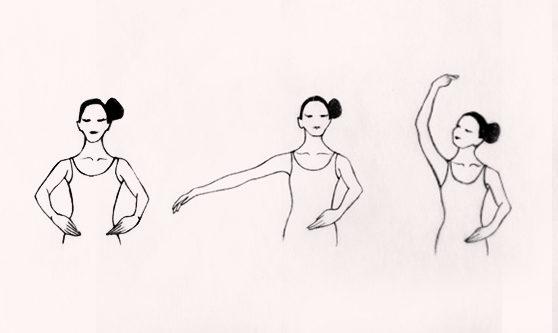 Hi Ballet Beauties! If you are a member of the Custom Workout, you know that many of our workouts include ballet terms. Ballet originated in the courts of France, therefore most of the ballet positions and movements are in French. Since Ballet Beautiful’s newest exclusive online workout series, Ballet Basics, is inspired by the fundamental movements and positions of classical ballet, we thought it would be helpful to provide a cheat sheet with definitions of all these terms.
We often get asked to explain the meanings so we hope this is a fun, helpful way for you to improve your workouts! Let us know if you have any other questions about the fundamentals of ballet or any other ways we can help you maximize your workout!
xoxo
The BB team!
Arabesque: A classic ballet position with one leg stretched long behind the dancer on the floor or in the air (height of the leg does not matter) and the back knee straight. The supporting leg can be straight or bent in a demi-plié.
Attitude: A position in which one leg is raised with the knee bent at a right angle and higher than the foot. The supporting leg can be straight, or in demi-plié, and the leg lifted can be to the front, side or back.
Fondu: Sinking down – a term used to describe the bending and stretching of the standing knee.
Passé: A movement in which the working leg lifts and passes along the supporting leg by the knee.
Plié: A bend of the knees. A full bending of the knees is a grand plié and a demi-plié is a half bending of the knees. The bending movement should be gradual and smooth, as should the rising movement.
Port de bras: Carriage of the arms. The graceful movement or passage of the arms from one position to another.
Relevé: Raised – a raising of the body on the ball of the foot or on demi-pointe.
Rond de Jambe: “Round” of the leg. A circular movement of the leg on the ground or in the air.
Rond de jambe en l’air: A raised circular movement of the leg in the air.
Supporting Leg: The supporting or standing leg is the one that holds the most weight in any movement or position.
Tendu: Tight or stretched – when the working leg is extended to either the front, side or back along the floor until only the tip of the toe remains touching the floor.
Working Leg: The leg that is executing a given movement while the weight of the body is on the supporting leg.
Hi Ballet Beauties! If you are a member of the Custom Workout, you know that many of our workouts include ballet terms. Ballet originated in the courts of France, therefore most of the ballet positions and movements are in French. Since Ballet Beautiful’s newest exclusive online workout series, Ballet Basics, is inspired by the fundamental movements and positions of classical ballet, we thought it would be helpful to provide a cheat sheet with definitions of all these terms.
We often get asked to explain the meanings so we hope this is a fun, helpful way for you to improve your workouts! Let us know if you have any other questions about the fundamentals of ballet or any other ways we can help you maximize your workout!
xoxo
The BB team!
Arabesque: A classic ballet position with one leg stretched long behind the dancer on the floor or in the air (height of the leg does not matter) and the back knee straight. The supporting leg can be straight or bent in a demi-plié.
Attitude: A position in which one leg is raised with the knee bent at a right angle and higher than the foot. The supporting leg can be straight, or in demi-plié, and the leg lifted can be to the front, side or back.
Fondu: Sinking down – a term used to describe the bending and stretching of the standing knee.
Passé: A movement in which the working leg lifts and passes along the supporting leg by the knee.
Plié: A bend of the knees. A full bending of the knees is a grand plié and a demi-plié is a half bending of the knees. The bending movement should be gradual and smooth, as should the rising movement.
Port de bras: Carriage of the arms. The graceful movement or passage of the arms from one position to another.
Relevé: Raised – a raising of the body on the ball of the foot or on demi-pointe.
Rond de Jambe: “Round” of the leg. A circular movement of the leg on the ground or in the air.
Rond de jambe en l’air: A raised circular movement of the leg in the air.
Supporting Leg: The supporting or standing leg is the one that holds the most weight in any movement or position.
Tendu: Tight or stretched – when the working leg is extended to either the front, side or back along the floor until only the tip of the toe remains touching the floor.
Working Leg: The leg that is executing a given movement while the weight of the body is on the supporting leg.
-
Train With Us
CUSTOM WORKOUT ONLINE SUBSCRIPTION
The ULTIMATE Online Ballet Workout! Personalized Playlists, NEW workouts, Livestreams & challenges every month PLUS 400+ Exclusive videos & Digital DVDs
Online Private WorkoutEnjoy our most PERSONALIZED form of VIP training online, from any location! Conquer your fitness goals and enjoy working out like never before!
LIVE ONLINE BOOTCAMPLive small-group Bootcamp style training led by our experienced team of Master Trainers.
-
Stream A Workout
CUSTOM WORKOUT ONLINE SUBSCRIPTION
The ULTIMATE Online Ballet Workout! Personalized Playlists, NEW workouts, Livestreams & challenges every month PLUS 400+ Exclusive videos & Digital DVDs
- Store
- About Us
- Blog






